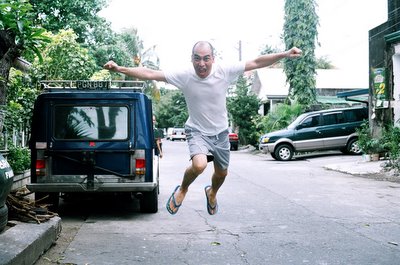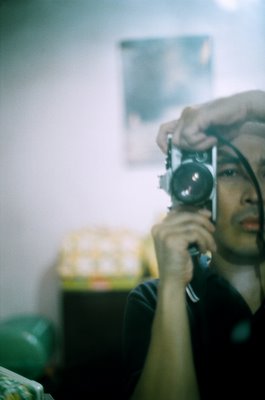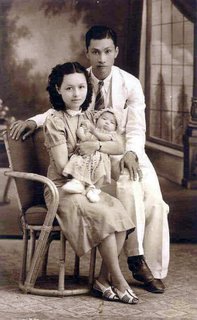I remember reading The Dangerous Summer when I was a bored teenager and found myself fascinated with the sport of bullfighting. The way Hemingway described it, bullfighting was more art than sport, more driven by honor than by bloodlust. In that summer of 1959, the superstar bullfighter of the day, Luis Miguel Dominguin, and the young upstart, Antonio Ordonez pushed each other, trying to outdo each other, taking more and more risks, to claim the title of 'the best'. Hemingway's writing was brutal, breviloquent, and beautiful, and having never seen an actual bullfight in its ritualistic entirety, I came away with romantic notions about the art and craft of killing bulls. It was years later that I would be able to see an actual bullfight, thanks to the Spanish TV station TVE Internacional. And Im sorry, Spain; try as I might, I never could find the beauty and artistry that drove Hemingway to tears that summer of '59. All I saw was a stupid animal being taken advantage of for sport and spectacle.
I was flipping channels yesterday morning when I saw a bullfight on TV. My younger daughter was awake and sat beside me. We watched as the matador with his retinue paraded the arena and saluted the crowd. Then the bull came out, a huge powerful beast, muscles seemingly wanting to burst through its hide. The bull galloped around the arena displaying its awesome strength. This bull was blonde, which piqued my interest that much more since I was used to seeing black bulls on TV. I was about to switch channels since I knew what was about to happen, but decided against it, using the opportunity to expose my daughter to a foreign culture. All she knows about bullfights are what she sees on cartoons. She'll ask questions and I'll do my best to answer.
First, the bull is tested by the matador and his alalays by waving pink and gold capes at it. The bull attacks the capes and the matador waves the cape around with all the art and attitude he can muster with a half ton animal charging at him at full speed, it's horns inches from his groin. Very nice. The bull gets as much applause as the matador, especially if it shows courage and determination in its attacks. The point being, I would guess, to establish the bull and the matador as two equally matched and worthy adversaries: the matador with his wits and cunning, and the bull with its raw power. This is all well and good, except that the match is anything but even.
After the 'suerte de capote', two picadores on armored and blindfolded horses come in and things start to get really ugly for the bull. The horses are blindfolded to prevent them from freaking out at the sight of the bull. The bull then attacks the horses, trying to impale their bellies with its horns. At this point, the horse, which won't win a Nobel prize for physics anytime soon, has no idea what's going on. It's only aware that something is trying to lift it from the ground, and is calm throughout. Meanwhile, the picador uses his lance to stab the bull about the neck and shoulders. Blood pours down on the bull's side, and because this one's blonde, the blood is clearly visible on the bull's hide. The bull keeps attacking the horses, while the picadores stab at it, leaning on their lances. (The lances have stops on them to prevent the lance heads from going in too deep. Theyre not supposed to kill the bull; only wound it.) My daughter's attention is rapt at this point. She's fascinated by the brutality of it all. "What's he doing?," she asks. "That's supposed to weaken the bull," I say. "They stab it to weaken the neck muscles so it won't be too strong for the matador." "That's a lot of blood," she says. Indeed it was.
After this, the matador and a couple of alalays are given two spiked banderillas. They taunt the bull to attack and then jab the banderillas into the bull's shoulders, further weakening it with loss of blood. The matador, if he's good, will stand squarely facing the bull, taunt it to attack, then sticks the banderillas onto the bull's shoulders from the front, with the bull's horns inches away from his face and neck. This to me is the most thrilling part of the corrida. The bull is weaker, but you know it's still strong enough to kill the matador with a well-placed jab; the matador not protected by a distracting cape, standing right in front of the charging bull, sticking his harpoons in the bull's hide with all the art and grace he can muster... then gets the hell out of there. There are wooden barriers he can go to to escape a bull's charge. The other alalays are there with the pink capes just in case things go wrong. If it seems that the matador might be in danger, they move in with their capes to distract the bull into charging them instead.
By this time, the bull's blonde hide is black with blood, its tongue hanging out from exhaustion. It has a dazed look in its eye and you'd think that it would just quit or drop dead right there and then. The matador then comes in with a sword and a small red cape. He taunts the dazed bull, who then charges. The matador now has more confidence to show off since the bull's charges are not as powerful. He pirouettes, he glides. He tiptoes, turns his back to the bull, at one point even touching it's forehead, all the while waving his cape with a flourish. The bull charges, his neck lower to the ground now from exhaustion, so much so that it once ended up catching its horns on the ground almost causing it to somersault over. The crowd cheers. I'd like to think theyre cheering the bull, too. There's just no quit in this animal. At the final series of passes, the bull's horns get caught in the ground again, but this time, the bull powers through, and all that energy stored in the bull's neck while the ground stopped its momentum is suddenly released, and the bull's head comes up fast, causing the matador to mistime a step. He was still moving forward when the bull's horns were coming up and only his reflexes saved him from getting disemboweled. The bull's horn caught his jacket and he was off-balance for a second. The ever-alert alalays move in to distract the bull til the matador regains his poise, this time with enough information about the bull: the speed of its charges, the position of its now-exhausted head; all this the matador factors in as he prepares to deliver his deathblow. He stands in front of the bull, his sword held at eye level, feet together with front leg bent and on tiptoes. A silly pose really, all cartoon-y, but it's part of the ritual. He holds the cape low and taunts the bull to charge. He is aiming for that spot between the bull's shoulders. The bull charges...
The matador lunges forward, between the bull's horns, and buries the sword between the bull's shoulders almost to the hilt, straight to the bull's heart. He moves away and basks in the crowd's cheers, the alalays distracting the still-standing bull who still tries with whatever strength it still has, to attack. Then it crumples to the ground, its legs giving way. A puntillero then delivers the final blow: a dagger through the bull's spine just where it attaches to the skull. The animal stiffens and falls dead.
"What are they going to do with it?" my daughter asks.
"Theyll eat it," I said.
I was flipping channels yesterday morning when I saw a bullfight on TV. My younger daughter was awake and sat beside me. We watched as the matador with his retinue paraded the arena and saluted the crowd. Then the bull came out, a huge powerful beast, muscles seemingly wanting to burst through its hide. The bull galloped around the arena displaying its awesome strength. This bull was blonde, which piqued my interest that much more since I was used to seeing black bulls on TV. I was about to switch channels since I knew what was about to happen, but decided against it, using the opportunity to expose my daughter to a foreign culture. All she knows about bullfights are what she sees on cartoons. She'll ask questions and I'll do my best to answer.
First, the bull is tested by the matador and his alalays by waving pink and gold capes at it. The bull attacks the capes and the matador waves the cape around with all the art and attitude he can muster with a half ton animal charging at him at full speed, it's horns inches from his groin. Very nice. The bull gets as much applause as the matador, especially if it shows courage and determination in its attacks. The point being, I would guess, to establish the bull and the matador as two equally matched and worthy adversaries: the matador with his wits and cunning, and the bull with its raw power. This is all well and good, except that the match is anything but even.
After the 'suerte de capote', two picadores on armored and blindfolded horses come in and things start to get really ugly for the bull. The horses are blindfolded to prevent them from freaking out at the sight of the bull. The bull then attacks the horses, trying to impale their bellies with its horns. At this point, the horse, which won't win a Nobel prize for physics anytime soon, has no idea what's going on. It's only aware that something is trying to lift it from the ground, and is calm throughout. Meanwhile, the picador uses his lance to stab the bull about the neck and shoulders. Blood pours down on the bull's side, and because this one's blonde, the blood is clearly visible on the bull's hide. The bull keeps attacking the horses, while the picadores stab at it, leaning on their lances. (The lances have stops on them to prevent the lance heads from going in too deep. Theyre not supposed to kill the bull; only wound it.) My daughter's attention is rapt at this point. She's fascinated by the brutality of it all. "What's he doing?," she asks. "That's supposed to weaken the bull," I say. "They stab it to weaken the neck muscles so it won't be too strong for the matador." "That's a lot of blood," she says. Indeed it was.
After this, the matador and a couple of alalays are given two spiked banderillas. They taunt the bull to attack and then jab the banderillas into the bull's shoulders, further weakening it with loss of blood. The matador, if he's good, will stand squarely facing the bull, taunt it to attack, then sticks the banderillas onto the bull's shoulders from the front, with the bull's horns inches away from his face and neck. This to me is the most thrilling part of the corrida. The bull is weaker, but you know it's still strong enough to kill the matador with a well-placed jab; the matador not protected by a distracting cape, standing right in front of the charging bull, sticking his harpoons in the bull's hide with all the art and grace he can muster... then gets the hell out of there. There are wooden barriers he can go to to escape a bull's charge. The other alalays are there with the pink capes just in case things go wrong. If it seems that the matador might be in danger, they move in with their capes to distract the bull into charging them instead.
By this time, the bull's blonde hide is black with blood, its tongue hanging out from exhaustion. It has a dazed look in its eye and you'd think that it would just quit or drop dead right there and then. The matador then comes in with a sword and a small red cape. He taunts the dazed bull, who then charges. The matador now has more confidence to show off since the bull's charges are not as powerful. He pirouettes, he glides. He tiptoes, turns his back to the bull, at one point even touching it's forehead, all the while waving his cape with a flourish. The bull charges, his neck lower to the ground now from exhaustion, so much so that it once ended up catching its horns on the ground almost causing it to somersault over. The crowd cheers. I'd like to think theyre cheering the bull, too. There's just no quit in this animal. At the final series of passes, the bull's horns get caught in the ground again, but this time, the bull powers through, and all that energy stored in the bull's neck while the ground stopped its momentum is suddenly released, and the bull's head comes up fast, causing the matador to mistime a step. He was still moving forward when the bull's horns were coming up and only his reflexes saved him from getting disemboweled. The bull's horn caught his jacket and he was off-balance for a second. The ever-alert alalays move in to distract the bull til the matador regains his poise, this time with enough information about the bull: the speed of its charges, the position of its now-exhausted head; all this the matador factors in as he prepares to deliver his deathblow. He stands in front of the bull, his sword held at eye level, feet together with front leg bent and on tiptoes. A silly pose really, all cartoon-y, but it's part of the ritual. He holds the cape low and taunts the bull to charge. He is aiming for that spot between the bull's shoulders. The bull charges...
The matador lunges forward, between the bull's horns, and buries the sword between the bull's shoulders almost to the hilt, straight to the bull's heart. He moves away and basks in the crowd's cheers, the alalays distracting the still-standing bull who still tries with whatever strength it still has, to attack. Then it crumples to the ground, its legs giving way. A puntillero then delivers the final blow: a dagger through the bull's spine just where it attaches to the skull. The animal stiffens and falls dead.
"What are they going to do with it?" my daughter asks.
"Theyll eat it," I said.



